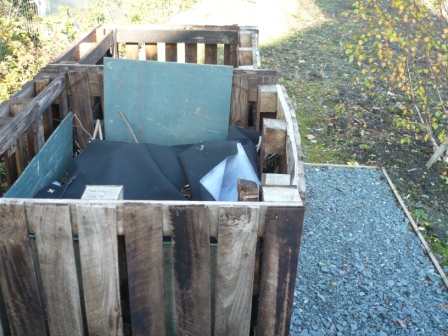Quicker Better Good Looking Compost
Quicker Compost Tips
- For winter keep the heat in your compost heap by covering the pile of rotting waste. Use old bubble wrap, old carpet or a rubberised blanket as shown on the heap above.
- Turn you heap to get air into the mix. I try to turn the heap every fortnight.
- Use a separate pile or a punctured plastic bag for old leaves which are slower to rot and have less nutrition. They do make excellent leaf mould.
- Chop up waste into small bits, it will rot quicker and more thoroughly .
- Use an accelerator by adding a spadeful of soil every 4 inches or ‘Garrotta’.
How do you Use Organic Compost
- Good compost mixed in with soil improves the condition, texture and water retention .
- Put compost in a planting hole for new trees and shrubs it helps to give them a good start.
- Compost around plants and trees acts as a mulch to conserve moisture and protect from frost.
- Feeding nutrients back into the soil particularly for heavy feeders like Dahlias, Onions or Runner Beans is one of the main uses of garden compost.
- Suppressing weeds can be achieved by mulching with compost.
- Replace the soil in the greenhouse where tomatoes have been grown.
- I have just made a new bed for next years Sweet peas from lots of home made compost.
- Recycles waste and reduces landfill or carbon dioxide emissions.

Check how you compost looks then use these tips to make it look and perform better.
How does your compost look?
- Black and sludgy compost has too much green waste and water. Mix it up with some shredded newspaper, saw dust or finely chopped woody prunings.
- Compost looks the same as 3 months ago, then there is no biological activity because it is too dry. Mix in more grass clippings and green waste. Add water preferably with some comfrey or nettle leaves soaked in it for a couple of weeks. Also consider using an activator of horse manure, good soil or a commercial product like Garrotta.
- Very twiggy but brown and sweet smelling then you need to shred the twigs of brown material and clippings more thoroughly or wait longer.
- Clumpy or layered and not mixed means similar materials have stayed together. Turn the heap over or give it a good stir to mix it well. Mix brown and green when adding to the heap.
- Compost that looks wet slimy and a bit smelly is lacking oxygen and brown material. Turn over and mix in more brown material.
- Full of small red worms is good news, leave it a bit longer so they can finish the job.
- Better lower down but uncomposted on the top. Take off the top and start a new compost heap with it whilst you use the well rotted stuff underneath. Or take from the bottom and let the pile settle back down.
- Looks OK but very slow to change may mean it is too cold so add some more nitrogen rich green matter and put a cover on the top and insulate the sides if necessary.
- Full of tree leaves that aren’t rotting. Put tree leaves in a separate pile or plastic bag with holes. Leaves rot slower, do not have much nutrient but make good leaf mould.
- Rotted in the centre but coarse around the edges make your heap larger and turn the edges into the centre.
- Well rotted but with some old roots or rough bits can be burried for a Runner beans row or riddled to remove worst roughage.
- Keep your compost looking tidy. Use a special bin or a fenced heap.
Read about Compost makers and activators.

2 thoughts on “Quicker Better Good Looking Compost”
Very good tips!
Comments are closed.